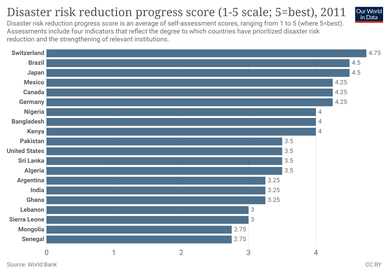
Back Ramprisikovermindering Afrikaans الحد من مخاطر الكوارث Arabic দুর্যোগ ঝুঁকি হ্রাস Bengali/Bangla Reducción del riesgo de desastres Spanish کاهش خطر فاجعه Persian Mitigasi bencana ID Mbelata ihe ize ndụ ọdachi IG 減災 Japanese 재난위기경감 Korean Rampenrisicovermindering Dutch

Disaster risk reduction (DRR) (or disaster risk management) is an approach for planning and taking steps to make disasters less likely to happen, and less damaging when they do happen. DRR aims to make communities stronger (more resilient or less vulnerable) and better prepared to handle disasters. When DRR is successful, it decreases the vulnerability of communities because it mitigates the effects of disasters.[2] This means DRR can reduce the severity and number of risky events. Since climate change can increase climate hazards, DRR and climate change adaptation are often looked at together in development efforts.[3]
Most sectors of development and humanitarian work have potential for DRR initiatives to be included. People from local communities, agencies or federal governments can all propose DRR strategies. Policies for DRR intend to "define goals and objectives across different timescales and with concrete targets, indicators and time frames."[2]: 16
There are some challenges for successful DRR. Local communities and organisations should be actively involved in the planning process. The role and funding of local government needs to be considered. Also, DRR strategies should be mindful of gender aspects. For example, studies have shown that women and girls are disproportionately impacted by disasters.[4] A gender-sensitive approach would identify how disasters affect men, women, boys and girls differently. It would shape policy that addresses people's specific vulnerabilities and needs.[5]
The Sendai Framework for Disaster Risk Reduction is an international initiative that has helped 123 countries adopt both federal and local DRR strategies (as of 2022).[6] The International Day for Disaster Risk Reduction, on October 13 every year, has helped increase the visibility of DRR. It aims to promote a culture of prevention.
Spending on DRR is difficult to quantify for many countries. Global estimates of costs are therefore not available. However an indication of the costs for developing countries is given by the $215 - US$387 billion per year (up to 2030) estimated costs for climate adaptation. DRR and climate adaptation share similar goals and strategies. They both require increased finance to address rising climate risks.[7]: 49
DRR activities are part of the national strategies and budget planning in most countries. However the priorities for DRR are often lower than for other development priorities. This has an impact on public sector budget allocations. For many countries, less than 1% of the national budget is available for DRR activities.[7]: 51 The Global Facility for Disaster Reduction and Recovery (GFDRR) is a multi-donor partnership to support developing countries in managing the interconnected risks of natural hazards and climate hazards. Between 2007 and 2022, GFDRR provided $890 million in technical assistance, analytics, and capacity building support to more than 157 countries.[7]: 54
- ^ "Disaster risk reduction progress score". Our World in Data. Retrieved 2024-04-04.
- ^ a b Cite error: The named reference
UNGAwas invoked but never defined (see the help page). - ^ McBean, Gordon; Rodgers, Caroline (2010). "Climate hazards and disasters: the need for capacity building". WIREs Climate Change. 1 (6): 871–884. doi:10.1002/wcc.77. ISSN 1757-7780.
- ^ Neumayer, Eric; Plümper, Thomas (2007). "The Gendered Nature of Natural Disasters: The Impact of Catastrophic Events on the Gender Gap in Life Expectancy, 1981–2002". Annals of the Association of American Geographers. 97 (3): 551–566. doi:10.1111/j.1467-8306.2007.00563.x. ISSN 0004-5608.
- ^ Cite error: The named reference
:2was invoked but never defined (see the help page). - ^ Cite error: The named reference
UNDRRwas invoked but never defined (see the help page). - ^ a b c Cite error: The named reference
UNDRR-2was invoked but never defined (see the help page).
© MMXXIII Rich X Search. We shall prevail. All rights reserved. Rich X Search